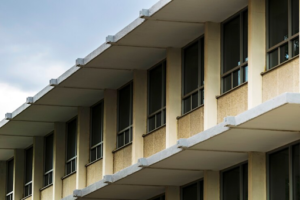Table of Content
- Beyond the Facade: Delving into the Components of a Building Envelope
- Beyond Protection: Unveiling the Multifaceted Functions of a Building Envelope
- Building a Better Future: Exploring the Benefits of a Well-Designed Building Envelope
- Building for the Future: Considerations for Designing an Effective Building Envelope
Imagine a building as a living organism. The Building Envelope, often referred to as its “skin,” acts as the crucial barrier that separates its internal organs – the conditioned spaces – from the external environment. Just like our own skin protects us from the elements, regulates our temperature, and contributes to our overall well-being, the building envelope plays a vital role in ensuring the functionality, comfort, and energy efficiency of a structure.
Beyond the Facade: Delving into the Components of a Building Envelope
The building envelope is not a singular entity, but rather a complex system comprised of various interconnected elements working in unison. Here’s a closer look at its key components:
- Exterior walls: These act as the first line of defense, providing structural support and insulation against the external environment. Materials like brick, concrete, timber, and various cladding systems can be employed, each offering unique properties and aesthetic considerations.
- Roofing system: The roof serves as the building’s crown, shielding it from rain, snow, sunlight, and other weather elements. It typically consists of roofing membranes, insulation layers, and structural elements like trusses or rafters, ensuring both weatherproofing and thermal performance.
- Windows and doors: These openings are essential for natural light, ventilation, and access, but also present thermal challenges. Choosing energy-efficient windows and doors with proper insulation and glazing is crucial to minimize heat transfer and air leakage.
- Air barriers: These are often hidden heroes, acting as membranes or sealant applications strategically placed throughout the Building Envelope. They minimize uncontrolled air leakage between the interior and exterior environments, significantly impacting energy efficiency and indoor air quality.
- Foundations: While not always explicitly considered part of the building envelope, foundations play a crucial role in moisture management and thermal performance. Proper foundation design and construction are essential to prevent water infiltration and ensure the overall integrity of the envelope system.
Beyond Protection: Unveiling the Multifaceted Functions of a Building Envelope
The building envelope goes beyond simply shielding the building’s interior. It fulfills several critical functions that contribute to the overall performance and well-being of the occupants:
- Weatherproofing: The building envelope acts as the primary barrier against rain, snow, wind, and extreme temperatures, safeguarding the building’s interior from the harsh elements and ensuring its longevity.
- Structural support: Certain components of the building envelope, like exterior walls and roof systems, contribute significantly to the structural integrity of the building, providing stability and resisting various external forces.
- Thermal control: The building envelope plays a pivotal role in regulating the building’s interior temperature. By providing insulation and minimizing heat transfer between the interior and exterior, it helps maintain thermal comfort and reduce energy consumption for heating and cooling.
- Acoustics: A well-designed building envelope can significantly impact the indoor acoustic environment. By incorporating sound-absorbing materials and proper detailing, it helps control noise transmission from outside, contributing to a quieter and more peaceful space for occupants.
- Aesthetics: The design and materials used for the Building Envelope significantly influence the overall aesthetics and architectural character of a building. From the choice of cladding materials to the style of windows and doors, the building envelope shapes the visual identity of the structure.
Building a Better Future: Exploring the Benefits of a Well-Designed Building Envelope
Investing in a well-designed and properly constructed building envelope offers numerous benefits that extend beyond aesthetics:
- Enhanced energy efficiency: By minimizing heat transfer and air leakage, a well-designed building envelope can significantly reduce energy consumption for heating and cooling. This translates to lower utility bills for building owners and tenants, while also contributing to a smaller environmental footprint and mitigating climate change impacts.
- Improved occupant comfort: A well-insulated and airtight building envelope helps maintain a comfortable indoor temperature year-round, reducing drafts and fluctuations. This not only enhances occupant comfort and well-being but also improves productivity and learning outcomes in educational and office environments.
- Durability and longevity: A properly designed and constructed building envelope using high-quality materials can extend the lifespan of the building and minimize the need for repairs and maintenance over time. This translates to significant cost savings in the long run for building owners and contributes to sustainable building practices.
- Healthier indoor environment: By minimizing uncontrolled air infiltration, a well-sealed building envelope can help reduce dust, allergens, and pollutants from entering the building, contributing to a healthier indoor air quality for occupants. This is particularly important for individuals with respiratory sensitivities or allergies.
- Increased building value: A well-designed and energy-efficient building envelope can enhance the overall value of a building, making it more attractive to potential buyers or tenants in a competitive market. This factor is becoming increasingly important as sustainability considerations gain prominence in the real estate landscape.
Building for the Future: Considerations for Designing an Effective Building Envelope
Designing an effective building envelope requires careful consideration of various factors that influence its performance and functionality:
- Climate: The local climate significantly influences the selection of materials and design strategies for the building envelope. Factors like temperature extremes, precipitation levels, and wind patterns need to be carefully analyzed to ensure the envelope can withstand the specific climatic conditions.
- Building use: The intended use of the building, such as residential, commercial, or industrial, will influence the specific requirements for thermal performance, acoustics, and durability. For example, hospitals will have stricter requirements for maintaining sterile environments, while industrial buildings may prioritize noise control and durability.
- Material selection: Choosing appropriate materials with the right thermal properties, durability, and sustainability considerations is crucial for optimizing the performance of the building envelope. This involves evaluating factors like insulation value, air permeability, water resistance, and embodied energy of the materials used.
- Construction practices: Proper installation and detailing of the various components of the building envelope are essential to ensure its effectiveness and prevent potential problems like leaks or moisture intrusion. This requires skilled labor, attention to detail, and adherence to best practices in construction techniques.
Conclusion: The Building Envelope – A Cornerstone of Sustainable and Healthy Built Environments
The building envelope is not just a passive barrier, but rather a dynamic system that plays a critical role in shaping the functionality, comfort, and sustainability of buildings. By understanding its components, functions, and benefits, building professionals and individuals can make informed decisions regarding design, construction, and maintenance practices. By prioritizing well-designed and well-maintained Building Envelopes, we can contribute to creating buildings that are not only comfortable and energy-efficient but also contribute to a sustainable future and promote the well-being of occupants.
Taking Action:
If you are involved in the design, construction, or maintenance of buildings, consider exploring resources and consulting with professionals specializing in building envelope design and construction. By staying informed about the latest advancements and best practices, you can play a vital role in creating buildings that are not only functional and aesthetically pleasing but also contribute to a more sustainable and healthy built environment for generations to come.





